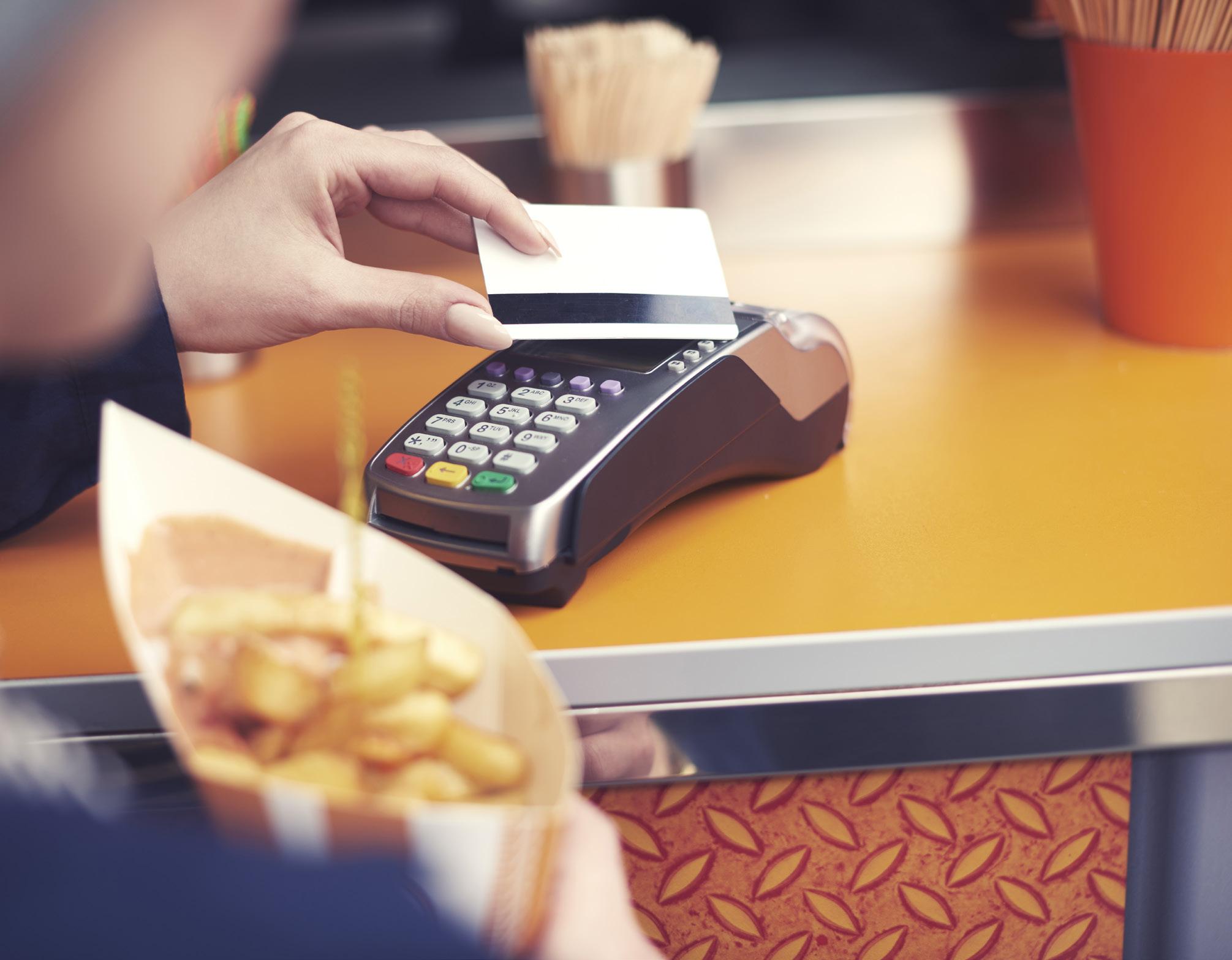
11 minute read
Be Future-Ready: The Case for Payments as a Service (Paas
3technologies to improve customer and employee experience during the pandemic
Although the use of contactless payments has steadily increased, the COVID-19 pandemic has pushed contactless toward mainstream adoption. An August 2020 survey found that one in five consumersi used contactless payments for the first time during the pandemic. Many believe this technology is essential moving forward, even after the pandemic subsides. In fact, according to a studyii by Entrust, 83% of respondents believe contactless cards are here to stay with 70% reporting they prefer contactless payment for sanitary reasons.
While contactless cards provide some solace for consumers worried about the risk of contracting the virus from payment devices, banks can go a step further and implement additional technology that will improve both customer and employee experience during the pandemic. Like contactless payments, the three technologies listed below may achieve mainstream adoption due to COVID-19, but their various advantages mean they’ll likely have long-term staying power in the financial services industries.
1. ID proofing authenticates identity remotely.
With COVID-19 cases surging across the U.S., many customers are limiting in-person visits to stores and other facilities, including bank branches. Unfortunately, many banks still require customers to physically visit a branch to open a new account or access certain services due to the difficulty of authenticating identity online.
You can help your customers stay safe by adopting ID proofing technology, which authenticates customers’ identities from a mobile device. The customer uses their device to photograph a government-issued photo ID, then takes a selfie for comparison via facial recognition technology. The user is then verified, denied or issued a challenge to further test their identity based on rules set by your company.
It’s important to note that ID proofing won’t work for every customer in every situation. No facial recognition algorithm is perfect, and many identify certain types of faces more accurately than othersiii. A genuine user could fail the facial recognition test due to poor lighting when their selfie was taken, or their physical appearance may no longer match their photo ID. Some customers lack official photo IDs or mobile devices with facial recognition capabilities.
That being said, the AI engines that refine these algorithms are getting better by the day, and soon ID proofing will enable everyone to open new accounts and access services without leaving their homes. This capability will continue to show dividends after the pandemic by making your customer experience more streamlined and convenient, removing friction from the account onboarding experience.
ID proofing involves collecting sensitive personal information, including biometric data. As such, it’s important to protect customers’ privacy by partnering with security providers that prioritize protecting personal data, as well as implementing strong cryptography strategies to avoid data breaches and other disruptions. Customers also deserve to know how their sensitive data is stored and used. Be transparent about your bank’s data practices and make sure you’re compliant with all current data privacy legislation.
2. Instant card issuance enables faster onboarding.

As we move toward a more on-demand future, customers will continue to want things instantly, including their payment cards. With instant card issuance, customers can drive to their banks and pick up a new card right away, rather than waiting several days for it to arrive in the mail. To minimize contact during the pandemic, banks can offer drivethru, touchless instant issuance, so customers don’t even have to step inside the bank. Then, they can immediately start using their new chipequipped card for safe, contactless payments.
Instant card issuance is relatively easy to adopt: All you need is an instant card printer and either an on-premises or cloud-hosted software stack. Look for one with a user-friendly interface that’s able to handle multiple card designs, including both credit and debit card profiles. Your printer should also include cybersecurity protections including secure booting, malware detection and encryption of user certificates to protect sensitive data. As more customers look to adopt contactless cards during and after the pandemic, this technology will be particularly important for banks to address that need. And we also expect that instant card issuance will continue to be popular in the post-COVID-19 world, for both sanitation and convenience purposes.
3. Single sign-on authentication streamlines employee access.
Creating and remembering secure passwords is a major burden for bank employees and customers alike. Financial information is incredibly sensitive and requires the highest levels of protection, but the strongest passwords are often the hardest to remember. And if a user needs to remember multiple passwords to access different services or accounts — or secure areas of a building — the difficulty is multiplied, and so is the potential for password theft or password fatigue.
Single sign-on (SSO) authentication alleviates this difficulty by tying access to multiple accounts to one password. Bank employees can sign in once on a mobile phone or device and gain access to computers, networks or areas of the bank building without the need to manage multiple passwords. By removing the need to type passcodes into keypads for room access, SSO can reduce opportunities for COVID-19 transmission among employees at work. It also streamlines the login and authentication process, improving productivity.

Most importantly, though, by eliminating the need to remember multiple passwords, SSO makes it easier for an employee to create a single, strong password to manage all their accounts. But with SSO, cracking one password can give a bad actor access to multiple platforms, so it’s especially important to avoid easy-to-guess combinations. Make sure to train employees on what constitutes a strong password and why it’s vital that theirs is secure.
Organizations can support security by implementing additional layers of protection, like two-factor authentication, as well as strong cryptography strategies that keep sensitive information safe. While no plan is 100% fool-proof, having a clearly defined strategy and team dedicated to protecting sensitive information is essential to maintaining customer and employee trust.
Thinking ahead to the post-COVID future
Any discussion of employee and customer experience today must take the impact of COVID-19 into account. With widespread distribution of vaccines on the horizon for 2021iv, however, it’s also important to think ahead to how today’s investments will play out after the pandemic. While ID proofing, SSO and instant card issuance offer sanitary benefits that are especially valuable during COVID-19, they also streamline customer and employee experiences in ways that will continue to improve ROI after the pandemic is just a memory. Andy Cease Product Marketing Manager Entrust

1
2
3
4
Steve Cocheo, E. (2020, August 29). More Consumers Prefer Contactless Payments for Pandemic Purchases. Retrieved January 05, 2021, from https://thefinancialbrand.com/101415/paymentcontactless-card-mobile-wallet-digital-coronavirus-covid-19pandemic-trend/
E. (n.d.). Retrieved January 05, 2021, from https://www.entrust. com/newsroom/press-releases/2020/consumer-survey-revealscontactless-cards-are-dominating-american-payment-preferences
Joy Buolamwini | Timnit Gebru /. (n.d.). Retrieved January 05, 2021, from http://gendershades.org/overview.html
Fox, M. (2020, December 14). When can I get a coronavirus vaccine? Retrieved January 05, 2021, from https://www.cnn.com/2020/11/30/ health/covid-vaccine-questions-when/index.html

Delivering Personalised Banking Service - Even When Remote
Banco Mercantil Santa Cruz has been the leading bank in Bolivia for the last 115 years, having demonstrated its commitment to Bolivia and its people through value offers, innovative products and an agile, efficient service. Mauricio Porro, Banco Mercantil Santa Cruz’s National Marketing and Planning Manager, agreed to speak to us to discuss the bank’s resilience under the unprecedented conditions brought on by the pandemic, and how their personalised approach to customer relations positions them to best meet Bolivia’s financial needs.
For the past several years, Banco Mercantil Santa Cruz has been working on refining and transforming their digital operations. This has stood them in good stead for when the pandemic hit, and services that allow customers to remain safely in their homes while performing transactions became all the more imperative. “Thanks to the digital transformation impulsed by our bank and managed for many years, we have been able to provide our clients with all the services from our mobile banking and internet banking platforms during these months of pandemic,” Mauricio told us. “We have made all the 24/7 banking service channels available to all our clients, providing them with continuous and permanent attention, which has brought us very satisfactory results. We have seen a significant change of behaviour in our clients who have used the digital channels to make their transactions.” This change in behaviour is reflected among the 30-million-plus transactions Banco Mercantil Santa Cruz has registered over the last six months, he confirmed. “During the most difficult months of the pandemic in Bolivia, at Banco Mercantil Santa Cruz more than 93% of transactions have been made through digital channels. There has been an important growth of operations made through alternative channels; our mobile banking has increased its level of transactions by 83%, exceeding 5 million transactions per month, and our call centre by 112%, being the two channels that have registered the highest growth.”
During such a challenging time, retail clients are in more need of personalised banking services than ever before. Mauricio explained how Banco Mercantil Santa Cruz has stepped up to meet those needs. “At Banco Mercantil Santa Cruz, throughout our history, we have been implementing a business model aimed to satisfy the financial needs of each of our users and even more during this pandemic, in which more than ever, we have to be close to them. In this sense, we have attended in a personalised way to the requirements of thousands of clients from all over the country through our alternative channels.
“One of the personalised services that we offer 100% digitally is the request for products totally online,” he continued. “The figures show that this service has been very well accepted by our clients; more than 30% of the accounts were opened digitally, and we take care of bringing their debit card straight to their door. In the same way, more than seven thousand people have used our online loan application platform, looking for financing options to buy properties, cars or simply a consumer loan.
“Likewise, through our consultation centre, our clients can carry out multiple operations, such as enabling mobile banking, user registration in internet banking and resetting passwords, among others. Our alternative channels have taken centre stage in recent times, and through them, we have provided personalised, comfortable and safe attention.”
It is evident that Banco Mercantil Santa Cruz has always held customer relations in high regard, and the conversation moved onto what steps the bank takes to maintain and grow those all-important relationships with customers.

“We are very grateful for the trust that our clients have given us,” Mauricio said. ”Satisfying the specific needs of each client is one of our top priorities, which rises from the commitment to provide them with the best financial experience in the market.
“Every day we work uninterruptedly to satisfy our customer’s financial needs, always listening to them, since their feedback is very important to improve each of our processes and products.
“We know today, due to technological development, our customers are increasingly demanding more efficiency, safety and speed. In this sense, uninterrupted investment in technology and innovation has also been fundamental, because it has allowed us to democratise financial services and strengthen the reach of our bank to all Bolivians, facilitating their lives and supporting them in their daily tasks.
“In addition to this, we are constantly looking for new ways to provide our clients with the best advantages and benefits in the market. We have the Benefits with B, from BMSC programme, through which all our customers who pay with their debit or credit cards from Banco Mercantil Santa Cruz can have access to daily discounts in more than 40 allied businesses nationwide in the areas of gastronomy, health, entertainment, home and shopping, among many others.
“Likewise, with our Banco Mercantil Santa Cruz Points Club, our clients can exchange their points for different products and services, among them, restaurants, cinemas, supermarkets and household products. Customers who make purchases with their debit or credit cards increase the average balance of their savings accounts, can open DPFs, and make transfers or card payments as well.
“These two programmes are implemented permanently and benefit all our clients. Our Points Club has been in effect for 12 years and thousands of customers have been able to redeem their points in the best shops in the whole country.”

Finally, we discussed the bank’s plans for the future. “We will continue working and betting on the development and growth of Bolivia, generating direct and indirect jobs and business opportunities,” Mauricio said. “At the same time, we will continue to pay attention to the needs of our clients, developing campaigns that reward their loyalty, and investing in digital solutions with added functionalities and improvements of the channels we already have, with the aim of providing them with the best benefits in the financial market.” Mauricio Porro National Marketing and Planning Manager Banco Mercantil Santa Cruz











